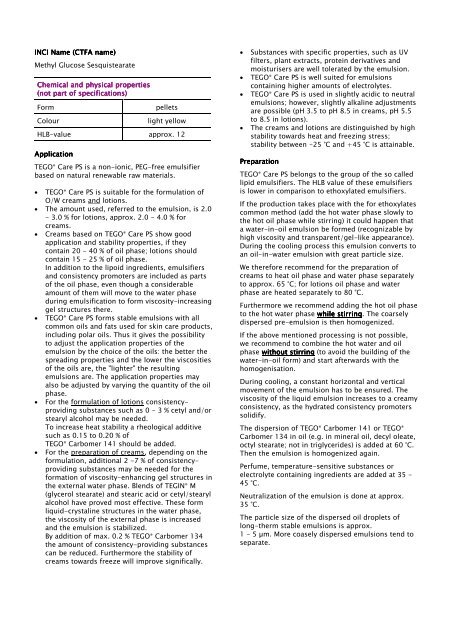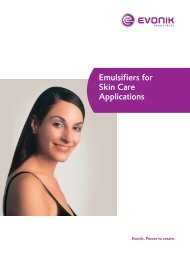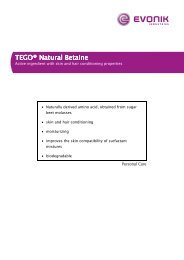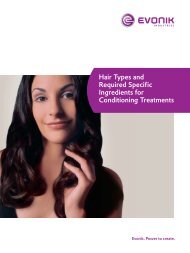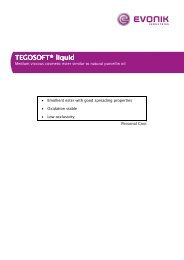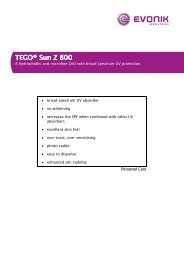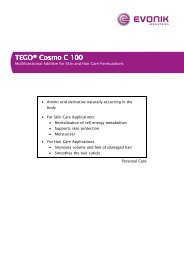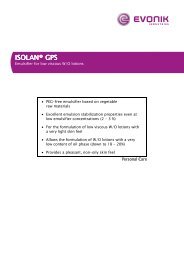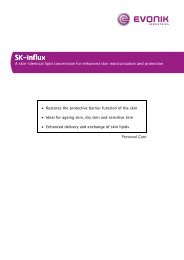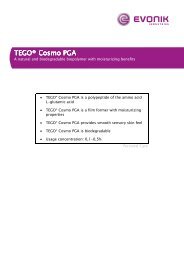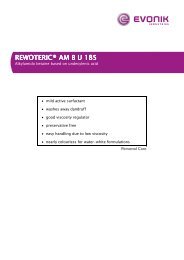TEGO® Care PS TEGO® Care PS
TEGO® Care PS TEGO® Care PS
TEGO® Care PS TEGO® Care PS
You also want an ePaper? Increase the reach of your titles
YUMPU automatically turns print PDFs into web optimized ePapers that Google loves.
INCI Name (CTFA name)<br />
Methyl Glucose Sesquistearate<br />
Chemical and physical properties<br />
(not part t of specifications)<br />
Form<br />
Colour<br />
pellets<br />
light yellow<br />
HLB-value approx. 12<br />
Application<br />
TEGO ® <strong>Care</strong> <strong>PS</strong> is a non-ionic, PEG-free emulsifier<br />
based on natural renewable raw materials.<br />
• TEGO ® <strong>Care</strong> <strong>PS</strong> is suitable for the formulation of<br />
O/W creams and lotions.<br />
• The amount used, referred to the emulsion, is 2.0<br />
- 3.0 % for lotions, approx. 2.0 - 4.0 % for<br />
creams.<br />
• Creams based on TEGO ® <strong>Care</strong> <strong>PS</strong> show good<br />
application and stability properties, if they<br />
contain 20 - 40 % of oil phase; lotions should<br />
contain 15 - 25 % of oil phase.<br />
In addition to the lipoid ingredients, emulsifiers<br />
and consistency promoters are included as parts<br />
of the oil phase, even though a considerable<br />
amount of them will move to the water phase<br />
during emulsification to form viscosity-increasing<br />
gel structures there.<br />
• TEGO ® <strong>Care</strong> <strong>PS</strong> forms stable emulsions with all<br />
common oils and fats used for skin care products,<br />
including polar oils. Thus it gives the possibility<br />
to adjust the application properties of the<br />
emulsion by the choice of the oils: the better the<br />
spreading properties and the lower the viscosities<br />
of the oils are, the "lighter" the resulting<br />
emulsions are. The application properties may<br />
also be adjusted by varying the quantity of the oil<br />
phase.<br />
• For the formulation of lotions consistencyproviding<br />
substances such as 0 - 3 % cetyl and/or<br />
stearyl alcohol may be needed.<br />
To increase heat stability a rheological additive<br />
such as 0.15 to 0.20 % of<br />
TEGO ® Carbomer 141 should be added.<br />
• For the preparation of creams, depending on the<br />
formulation, additional 2 -7 % of consistencyproviding<br />
substances may be needed for the<br />
formation of viscosity-enhancing gel structures in<br />
the external water phase. Blends of TEGIN ® M<br />
(glycerol stearate) and stearic acid or cetyl/stearyl<br />
alcohol have proved most effective. These form<br />
liquid-crystaline structures in the water phase,<br />
the viscosity of the external phase is increased<br />
and the emulsion is stabilized.<br />
By addition of max. 0.2 % TEGO ® Carbomer 134<br />
the amount of consistency-providing substances<br />
can be reduced. Furthermore the stability of<br />
creams towards freeze will improve significally.<br />
• Substances with specific properties, such as UV<br />
filters, plant extracts, protein derivatives and<br />
moisturisers are well tolerated by the emulsion.<br />
• TEGO ® <strong>Care</strong> <strong>PS</strong> is well suited for emulsions<br />
containing higher amounts of electrolytes.<br />
• TEGO ® <strong>Care</strong> <strong>PS</strong> is used in slightly acidic to neutral<br />
emulsions; however, slightly alkaline adjustments<br />
are possible (pH 3.5 to pH 8.5 in creams, pH 5.5<br />
to 8.5 in lotions).<br />
• The creams and lotions are distinguished by high<br />
stability towards heat and freezing stress;<br />
stability between -25 °C and +45 °C is attainable.<br />
Preparation<br />
TEGO ® <strong>Care</strong> <strong>PS</strong> belongs to the group of the so called<br />
lipid emulsifiers. The HLB value of these emulsifiers<br />
is lower in comparison to ethoxylated emulsifiers.<br />
If the production takes place with the for ethoxylates<br />
common method (add the hot water phase slowly to<br />
the hot oil phase while stirring) it could happen that<br />
a water-in-oil emulsion be formed (recognizable by<br />
high viscosity and transparent/gel-like appearance).<br />
During the cooling process this emulsion converts to<br />
an oil-in-water emulsion with great particle size.<br />
We therefore recommend for the preparation of<br />
creams to heat oil phase and water phase separately<br />
to approx. 65 °C; for lotions oil phase and water<br />
phase are heated separately to 80 °C.<br />
Furthermore we recommend adding the hot oil phase<br />
to the hot water phase while stirring. The coarsely<br />
dispersed pre-emulsion is then homogenized.<br />
If the above mentioned processing is not possible,<br />
we recommend to combine the hot water and oil<br />
phase without stirring (to avoid the building of the<br />
water-in-oil form) and start afterwards with the<br />
homogenisation.<br />
During cooling, a constant horizontal and vertical<br />
movement of the emulsion has to be ensured. The<br />
viscosity of the liquid emulsion increases to a creamy<br />
consistency, as the hydrated consistency promoters<br />
solidify.<br />
The dispersion of TEGO ® Carbomer 141 or TEGO ®<br />
Carbomer 134 in oil (e.g. in mineral oil, decyl oleate,<br />
octyl stearate; not in triglycerides) is added at 60 °C.<br />
Then the emulsion is homogenized again.<br />
Perfume, temperature-sensitive substances or<br />
electrolyte containing ingredients are added at 35 -<br />
45 °C.<br />
Neutralization of the emulsion is done at approx.<br />
35 °C.<br />
The particle size of the dispersed oil droplets of<br />
long-therm stable emulsions is approx.<br />
1 - 5 m. More coasely dispersed emulsions tend to<br />
separate.


